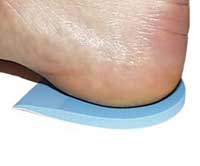By Steve Hefferon, CMT, PTA and co-founder of LoseTheBackPain.com

One of the questions we get very often here at the Healthy Back Institute is, do heel lifts cause back pain?
Well, the answer is, yes, they can and often do and that is why we discourage people from going straight into heel lifts. Back pain sufferers need to understand why wearing lifts might end up prolonging their pain. Heel lifts can work against you achieving the physical balance necessary for a pain-free pelvis or back.
Knowing the right question makes whoever is answering think more, communicate better and give you a clearer answer. If a healer says you have one leg shorter than the other, always ask, “Are we talking about a leg-length difference or a leg-length discrepancy?”
A leg-length difference occurs when the length of bones are different between one leg and the other. The way to measure is by x-ray. A leg-length discrepancy, however, is when one leg appears to be shorter because one side of your hip has gone higher than the other. The difference between these two conditions is vital when it comes to recommending use of a heel lift.
A client once complained to me that his 5/16th of an inch heel lift did not feel right. We tried removing it, but this was not satisfactory, either, so I recommended asking his doctor for an x-ray. We discovered the real difference in length between his two legs only amounted to 1/16th of an inch. The lift’s extra 4/16th of an inch was actually keeping my client from developing the physical balance necessary to achieve pain-free living.
1/16th of an inch difference is not a lot, and our bodies can accommodate it. But, first, you and your doctor need to know if you have a difference or a discrepancy. Physical therapists, podiatrists or medical doctors will have you using a lift to provide a momentary answer, but lifts are not good for improving long-term balance and a more stable pelvis.
It is possible to be born with legs of different length. Also, total hip or knee replacement patients may have significantly shorter legs. However, doctors should never assume this condition exists and recommend heel lifts, or orthotics with built-in lifts without digging further to understand what’s actually going on for the individual.
Leg-length discrepancies are often caused by how we hold ourselves, how we stand. Women carrying babies on one hip, say, can produce discrepancies. In general, habits, patterns, posture and positioning — things we do all day long — control the way our pelvis is conditioned. Very specific sets of muscles are associated with a discrepancy. Until you know your true condition, you cannot know exactly what to do.
When lift-wearers know which condition they suffer from, the next step is to work with the maker of the lift to gradually decrease its height as you increase your strength and bring your body back to a more balanced, more stable state. This is the ideal: to be natural and balanced so you can withstand the stress and strain of your day.
Once I accurately diagnose a client’s condition, what makes all the difference in dealing with their pain are stretching and exercising. Not any haphazard program, either, but an integrated corrective exercise program tailored specifically to the individual client’s special needs. I always and whole-heartedly recommend our Muscle Balance Therapy approach as the foundation of any back pain relief plan.
Muscle Balance Therapy, first of all, makes possible understanding how and why your body is out of alignment. It helps identify muscle imbalances and postural dysfunctions which are the root cause of your pain. Then a program of very specific and personally targeted exercises help your body become stronger, more flexible and better balanced.
Starting today you the sufferer can take control of achieving the long-term relief that comes with a more neutral, natural and stable pelvis. Muscle Balance Therapy has worked for thousands of back and pelvis pain victims worldwide. In all sincerity, let me ask you what I believe is the right question. Isn’t it time to get rid of your heel lifts?
50 Years of Back Pain Gone in Just Days!
Jerry Talisman had suffered from chronic back pain on and off for over 50 years. Like most people, he had tried it all… chiropractors, physical therapy, he even overdosed on tylenol but nothing gave him lasting relief until he discovered muscle balance therapy.
Unlike most treatments which only deliver temporary relief, if any at all, muscle balance therapy delivers lasting relief to 8 out of 10 people who use it because it addresses the underlying cause of the pain, not just the symptoms.
If you suffer from any type of back pain, neck pain or sciatica, I urge you to learn more about this breakthrough new treatment. Click here to learn more…



Should you ever put a heel lift in the shoe of the hip side that is tilted up. I’ve been wearing one on the side that is tilted down but my physical therapist changed it. When I look in the mirror the right side is tilted down over an inch maybe 2 and was considering getting a whole shoe lift.
Is the therapist correct?
Thanks
Jimmy
Jimmy, If the lengths of your bones are different, then it an option. If the pelvis is in an abnormal position and makes it look like the lengths are different, that is called a (leg length discrepancy) and in that case, we do not believe a lift should be used.
If you are currently using one, we suggest you seek several opinions on the matter… As it is not a simple solution at this point, the body has accommodated to the lift and any changes will cause changes elsewhere…
Thanks
Steve
thanks
I just had a lift put on my shoe on my longer leg instead on my shorter leg it just made me limp a lot and my back hurts he I hope will put it on the shorter leg shoe my hips were not lining and pelvic is off I hope I am making the right decision having the lift
I don’t have short leg syndrome. 2 weeks after taking orthotic outta my shoes I couldn’t walk. 1/8 lift put in right shoe. As of 2016 I’m finally have a Dr trying to find out to give me a diagnosis. Daily pain walk with walker . I’m so confused
How about wearing 1/8lift in right shoe for about 2 years to get another prescription for short leg syndrome. After being told that is incorrect 2 weeks after removing orthotics quake up and can’t walk. I haven’t been the same since